In this article:
Many babies develop scaly, greasy patches on their scalp, which is a form of seborrheic dermatitis called cradle cap. It is mostly a cosmetic concern and does not cause itching, pain, or discomfort.
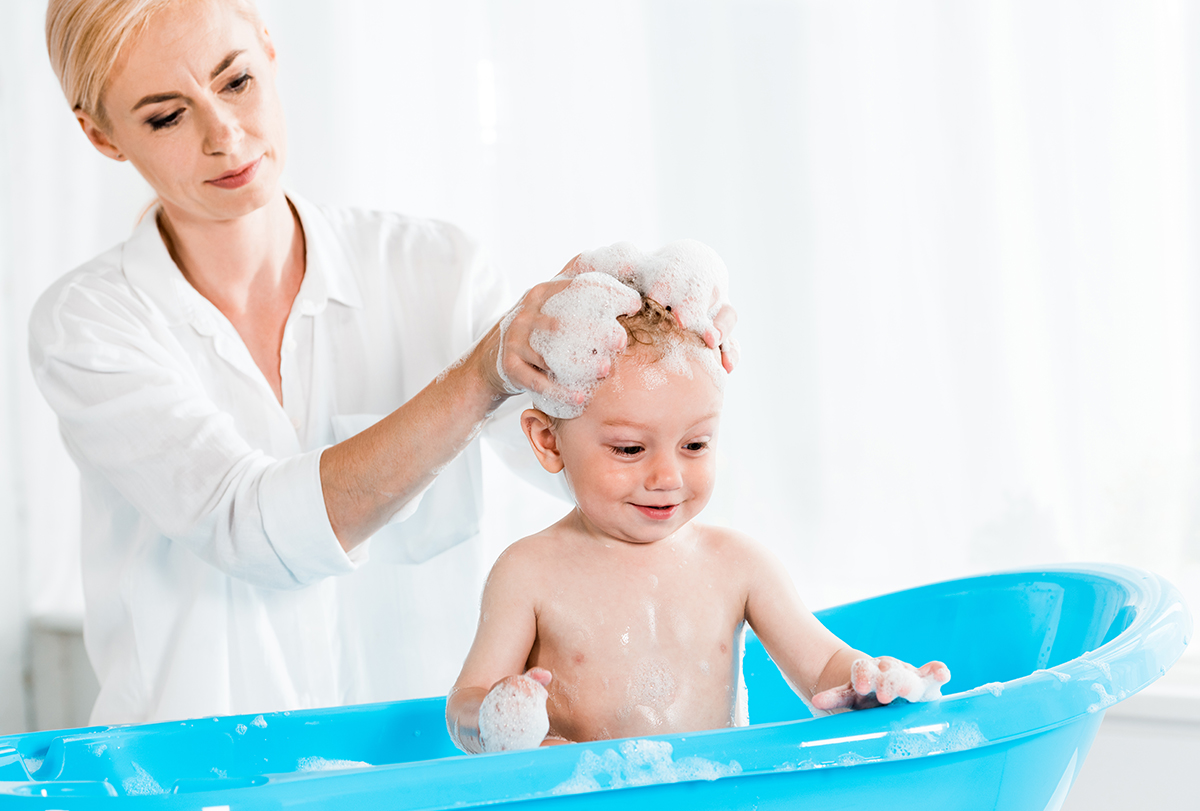
However, scratching or plucking the scaly patches can cause skin tearing, tissue damage, bleeding, and even infection. So you must exercise gentleness and care when handling this condition, especially since the baby’s scalp is ultrasensitive.
Cradle cap doesn’t necessarily need treatment, but there are things you can do at home to get rid of it more quickly.
Causes of Cradle Cap
The underlying cause of cradle cap is largely unknown, which makes it difficult to prevent.
But babies get certain hormones from the mother that trigger the overproduction of sebum or oil during the prenatal period. The scalp contains a lot of sebaceous glands that are attached to each hair follicle and ooze out excess oil, contributing to the formation of cradle cap.
The good news is the condition usually resolves on its own as these hormones get cleared from the baby’s body within a few months of birth.
Unfortunately, as long as the condition persists, the greasy scalp can become a breeding ground for a type of yeast (fungus) called Malassezia and other bacteria that feed on sebum. This is why doctors often prescribe antifungal treatments, such as ketoconazole, for cradle cap.
Home Remedies for Cradle Crap
Here are a few easy ways to treat cradle cap at home.
1. Wash your baby’s hair more frequently
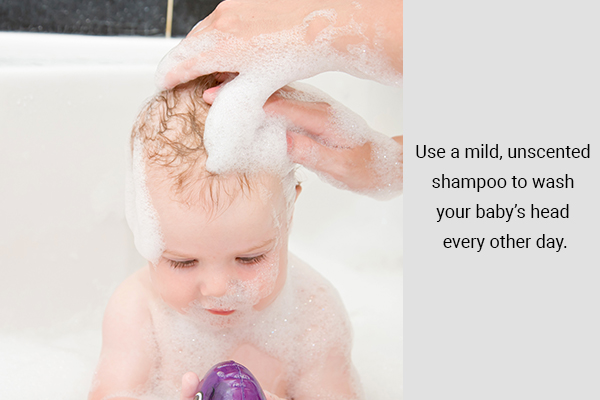
Use mild, unscented shampoo to wash your baby’s head every other day. Gently massage the shampoo all over the scalp to soften and loosen the scaly skin and thus make it easier to remove. (1)
However, if your baby has a preexisting skin condition such as eczema, frequent shampooing can further aggravate cradle cap. In such cases, consult a pediatrician or dermatologist to determine how often to bathe the baby.
If you are not getting results from regular baby shampoo, switch to one that is specifically formulated for this condition. Such shampoos carry the term “cradle cap” on their packaging.
If you are unable to find one, ask your dermatologist for a recommendation. You can even make your own shampoo for treating cradle cap.
2. Apply baby oil or petroleum jelly
Cradle cap leads to hard crusty patches on the baby’s scalp. Scrubbing, peeling, or scratching these patches can rupture the skin and cause bleeding and even infection.
Applying a lubricant such as baby oil or petroleum jelly can help soften these crusts to make them easy to remove. Just massage a bit of the product onto the flaky skin, let it sit for a while, and then rinse it off with a baby shampoo. Make this a pre-bath ritual for your baby. (1)(2)
Once the crusty layer becomes a bit loose, use a cotton bud or soft baby toothbrush to gently scrub it off.
Note: Do not use olive oil as it can increase the growth of yeast on the scalp.
3. Use shea butter
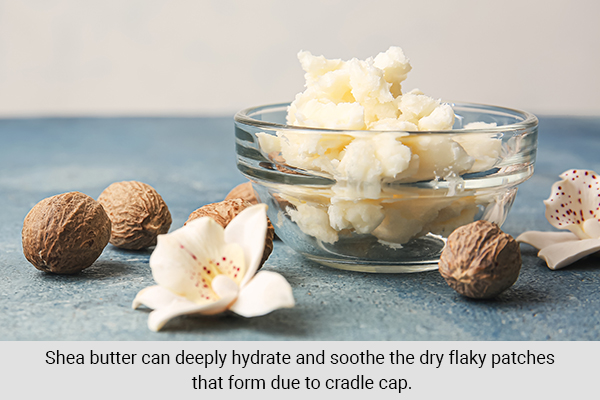
Shea butter can deeply hydrate and soothe the dry flaky patches that form due to cradle cap.
Gently massage ½ tbsp of shea butter on the baby’s scalp and let it get absorbed for a while. The moisturizing effect will soften the crusty layer and separate it from the underlying skin, making it shed easily.
Then, slowly run a soft brush over your scalp to scrub off the loose skin. You can also gently wipe the shea butter from the scalp with a soft cloth or rinse it off with water.
4. Make use of breast milk
Breast milk is considered the most wholesome food for infants. It is replete with all kinds of nutrients that help your baby grow.
Moreover, babies are born without any antibodies, which leaves them extremely vulnerable to infections and illnesses. Breast milk contains the mother’s antibodies, which are transferred to the baby and help build their immunity. (3)
In addition to these two main functions, breast milk can also be used topically to get rid of cradle cap. When massaged on the patches, it may help loosen the scaly flakes so that they come off easily.
How to use:
- Mix a little bit of breast milk in your baby’s shampoo. Gently massage the mixture all over the baby’s scalp, particularly the scaly patches. Lightly brush the scalp afterward to further loosen the flaky skin.
- Alternatively, you can directly rub some breast milk onto the baby’s scalp after a hair wash.
5. Try calendula
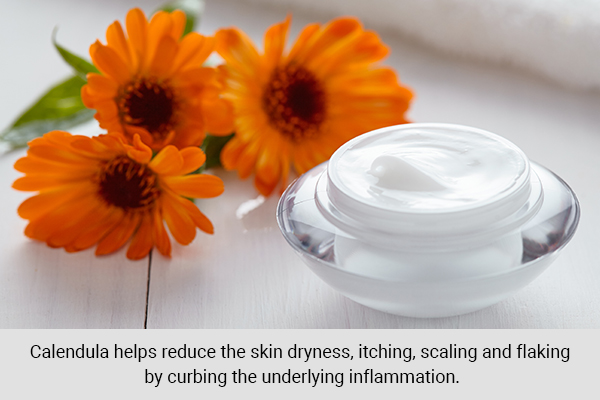
Calendula is a medicinal herb credited with antimicrobial, antigenotoxic, and anti-inflammatory activities, which make it a safe and effective remedy for cradle cap. It helps reduce skin dryness, itching, scaling, and flaking by curbing the underlying inflammation.
Plus, the broken skin can easily get infected, but calendula can help keep germs away. Thus, this remedy not only soothes the skin irritation associated with this condition but also promotes skin healing. (4)
Simply apply calendula cream or calendula oil to the scaly patches to make them go away faster.
6. Brush it away
Scratching or picking at the scaly patches caused by cradle cap will only make it worse. It can damage the sensitive scalp, aggravate the pain and irritation, and increase the risk of infection.
A safer technique is to gently brush the baby’s scalp after shampooing or a few hours after oiling. The moisture will soften the scaly skin so that it can easily be scrubbed off without damaging the scalp itself.
You can either use a natural brush with very soft bristles or a warm, wet washcloth to lightly exfoliate the scalp.
7. Use a humidifier
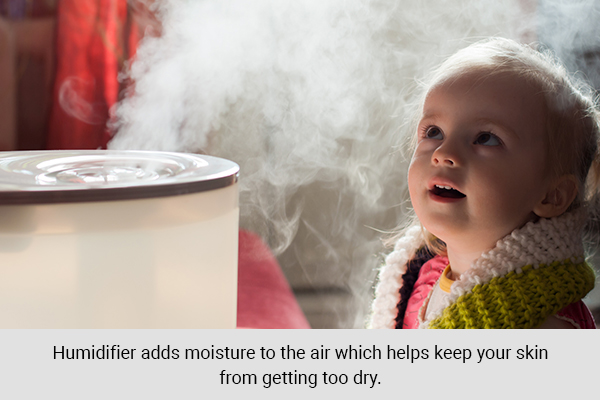
Cradle cap is characterized by excessively dry and irritated skin on the scalp.
Installing a humidifier in your baby’s room can help reduce skin dryness and soothe the overall scalp discomfort. This device adds moisture to the air, which helps keep your skin from getting too dry.
When to See a Doctor
Cradle cap is a benign condition that clears on its own within 3–6 months after birth. But you must seek medical help in the following cases:
- If the condition worsens over time.
- If the condition persists for more than a year.
- If the patches spread to the baby’s face or body.
- If the baby develops a severe rash that extends beyond the scalp.
- If you notice any odor or discharge coming from the patches.
- If the baby seems to experience pain or itching on the scalp.
In such cases, a board-certified dermatologist will prescribe a medicated shampoo, lotion, or other treatment to address the condition.
Most-Asked Questions About Cradle Cap

Can cradle cap resolve without any treatment?
Most of the time, cradle caps do resolve on their own. However, treatment may help it go away faster by inhibiting the buildup of thick scales and plaques that may get infected with fungus.
Daily cleansing, washing, and brushing can help resolve it faster.
How long does it take for cradle cap to go away?
It depends on the severity of the infection. Cradle cap may take weeks to months to clear, but severe cases may take up to a year.
Does cradle cap increase the risk of hair fall in children?
The hair is not affected, but in extreme cases, thick plaques may cause temporary hair loss in children.
Final Word
Cradle cap is a painless condition that affects most babies but is unlikely to harm them in any way. The scaly patches tend to go away on their own without leaving behind any scars or discoloration. This can take from a few weeks to a few months, but rarely more than a year.
While you don’t need treatment for cradle cap, consult a doctor if you notice anything unusual or you just want to be careful about your baby’s health.
- Was this article helpful?
- YES, THANKS!NOT REALLY


